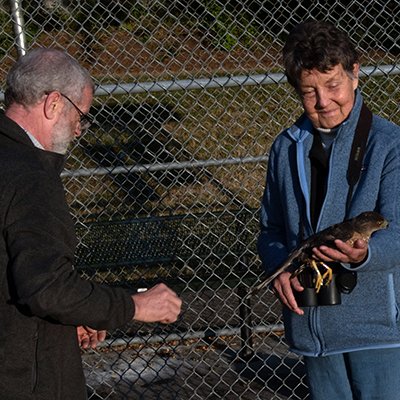URC Update | Autumn 2021
2021 Seattle Cooper’s Hawk Project:
Annual Report

Purple S-5 as a juvenile, Queen Anne, October 2020 (Elaine Chuang)
Cooper’S hawk S-5
- June: Caught inside an Interbay warehouse. Chris Anderson (WDFW) and Ed Deal chased him out of the building before it closed for the weekend of the heat wave, when he surely would have died.
- 5 August: Photographed in Wallingford.
- 14 August: Seen at NW 44th & 2nd NW (Fremont) as Patti Loesche drove by with a loaded trap in her car. He fell for the trick again, posed for pictures, and was released.
- 11 October: Photographed five blocks south (NW 39th & 2nd NW).
The Seattle Cooper’s hawk population keeps on growing, no matter what obstacles Mother Nature and human nature throw at it. The wild card this year was an unprecedented three days of 100+ degree temperatures in June, during peak nesting season. The consequences slowed, but did not stop, the annual growth of the Seattle Cooper’s hawk population.
By season’s end, URC volunteers and backyard informants had found 69 nests; 52 of them fledged 192 young. We found eight more nests than in 2020, but many more nests failed this year (17) than in 2020 (10). Some of these losses were heat mortalities. We know of four chicks that were lost from two nests during the heat wave and suspect that at least two of the 17 nest failures were also heat-related. The high temperatures caused some chicks to abandon their nests before they could fly, and at least a dozen in the Puget Sound region were rescued and taken to PAWS Wildlife Center (see our Summer 2021 newsletter).
URC banders put color-ID bands on 72 Coops (58 fledglings, 14 adults); 15 of those fledglings were heat refugees at PAWS. Band re-sightings to date (125) have already far exceeded the previous annual record in 2020 (95). Since 2012, we have banded 418 Coops, with 470 re-sightings of 181 different birds, an excellent return rate of 43%. The vast majority of sightings are year-round in Seattle (399) or non-Seattle parts of King County (38), indicating a non-migratory population.
Here’s where we open the photo album and tell you about the grandkids. Notable band sightings in 2021:
- Blue E-V is one of only two known survivors of the 269 Coops banded by Jack Bettesworth, founder of the Seattle Cooper’s Hawk project. Banded in January 2011, E-V fledged four young in a north Seattle park for the 11th year, a total of 41 progeny—a new record for the project.
- Orange (female) right 6-V was banded as a fledgling in West Seattle in July 2015. She was found injured in Rainier Valley in January 2019 and taken to PAWS. A storm just before release damaged the netting on her flight cage and she escaped. In August 2021, over two years later, her band was photographed in Leschi Park. After that 2019 escape, she probably made her way from PAWS in Lynnwood back “home” and has been nesting in the neighborhood for at least five years, eluding our searches all this time.
- Purple (male) left S-5 has been busy. Banded as a fledgling in Magnolia in July 2020, he was photographed on Queen Anne in October 2020. He has been spotted four times in 2021 and may be homing in on a territory (see box left).
- Orange right D-W, banded as a fledgling in West Seattle in July 2020, found her way to Capitol Hill and nested absurdly low in a tree in a highly urban neighborhood. The Miller Park pickle ball regulars loved watching her and her family go, indifferent to all the nearby activity. She fledged five kids, which we trust significantly dented the neighborhood rat population. In July, Martin Muller banded her mate, Mr. Purple U-6.
- Orange right N-3 was banded in July as a fledgling in Woodland Park. She was photographed in Bellingham on 26 August—an amazing 89-mile dispersal only 6-7 weeks post fledging!

Orange 6-V, Leschi Park (Terri Silver)
Ed Deal published an extensive review article on our study species:
The Cooper’s Hawk: history and current status in Washington. Washington Birds, 13:81-96.

Purple S-5 molting into adult plumage, Wallingford, August 2021 (Megan Coughlin)

Penny Lewis releases Purple U-6 as Martin Muller looks on. (Jeff Graham)
Finally, a tale of two releases. Two young Cooper’s hawks prematurely left their nests during the June heat wave and were taken to PAWS. Once they could fly, they were banded and released back to their parents and siblings. Fledglings typically depend on their parents for food for at least a month. The first fledgling was released near Matthews Beach. He apparently failed to reintegrate with his family and was found dead nine days later and 20 miles away on the beach in Des Moines. The second fledgling was released in Georgetown in early July. She has been seen twice since: at the grain terminal next to Myrtle Edwards Park (24 August) and later near Gasworks Park (4 October). We have assisted with many releases of rehabbed fledglings, and we are still learning what ensures a successful release.
Ten years ago, when Martin and Ed took over the Seattle Cooper’s hawk study from Jack, we tallied 22 nests and 68 fledglings. Those numbers have now tripled, and with it the time demanded to do the work well. We at URC give thanks for all the love, support, volunteer hours, and donations we have received from the bird community over the past year. We wish you all good health and many Coop sightings.
Ed Deal, Patti Loesche, Martin Muller
Urban Raptor Conservancy
https://urbanraptorconservancy.org/
info@urbanraptorconservancy.org